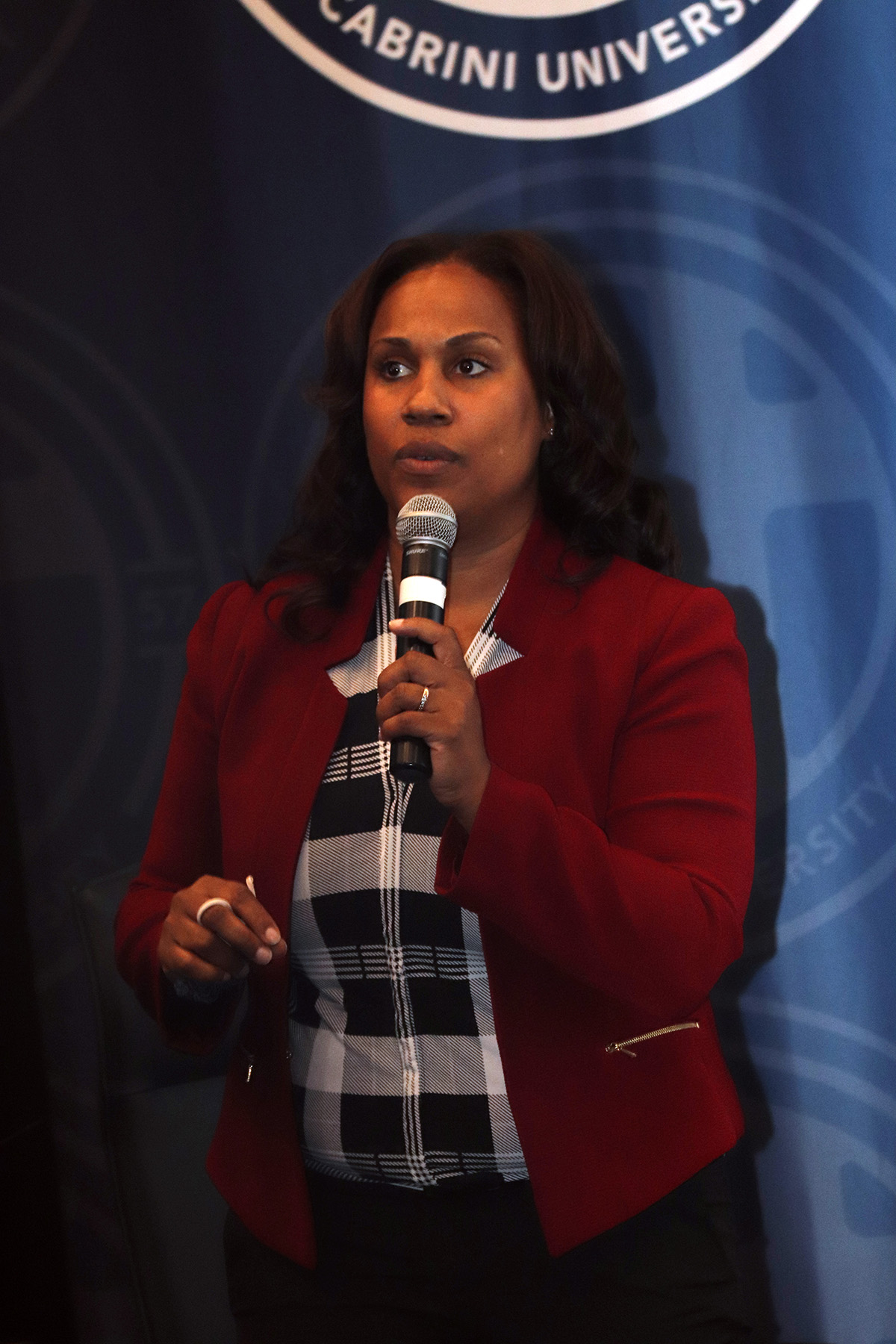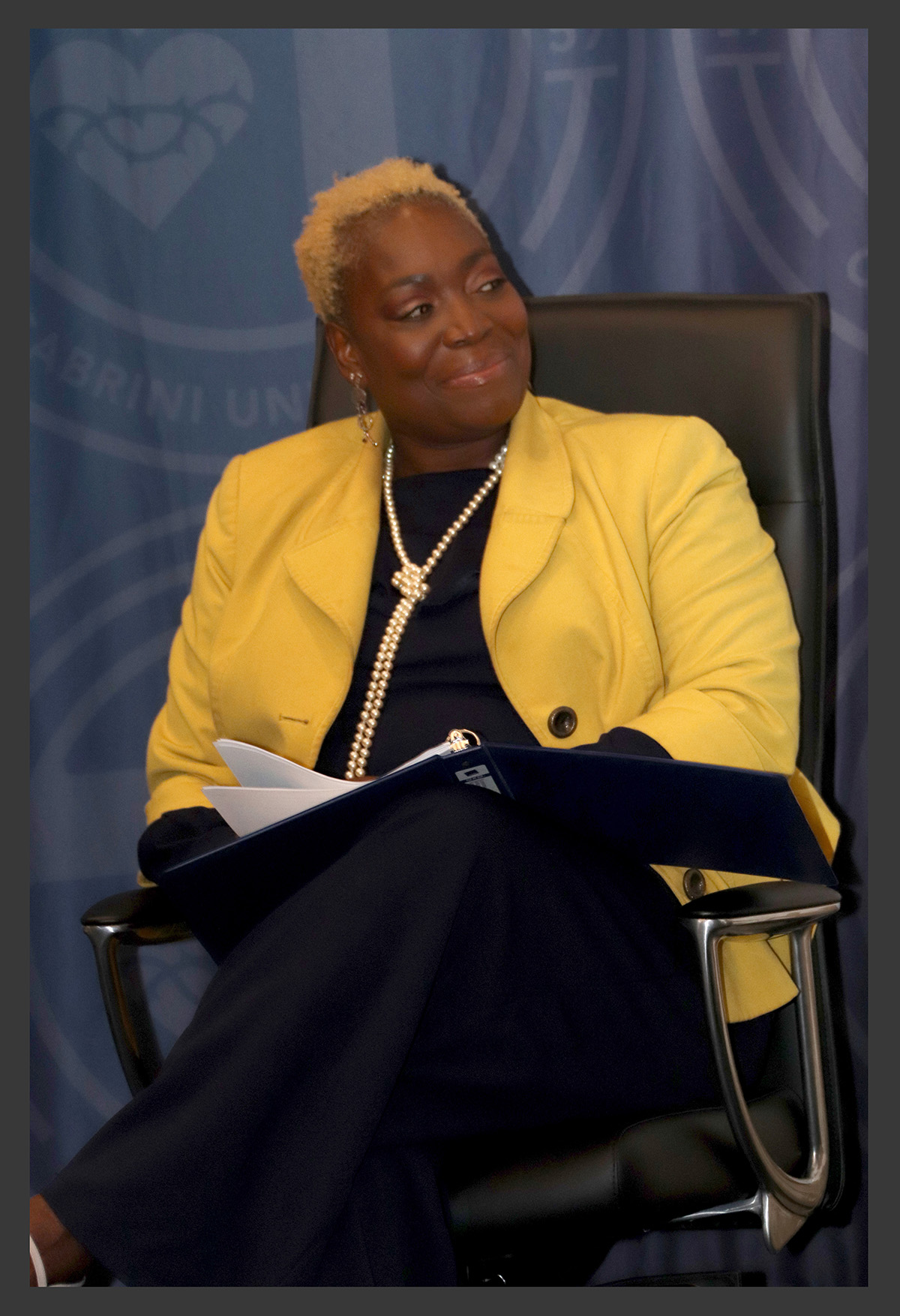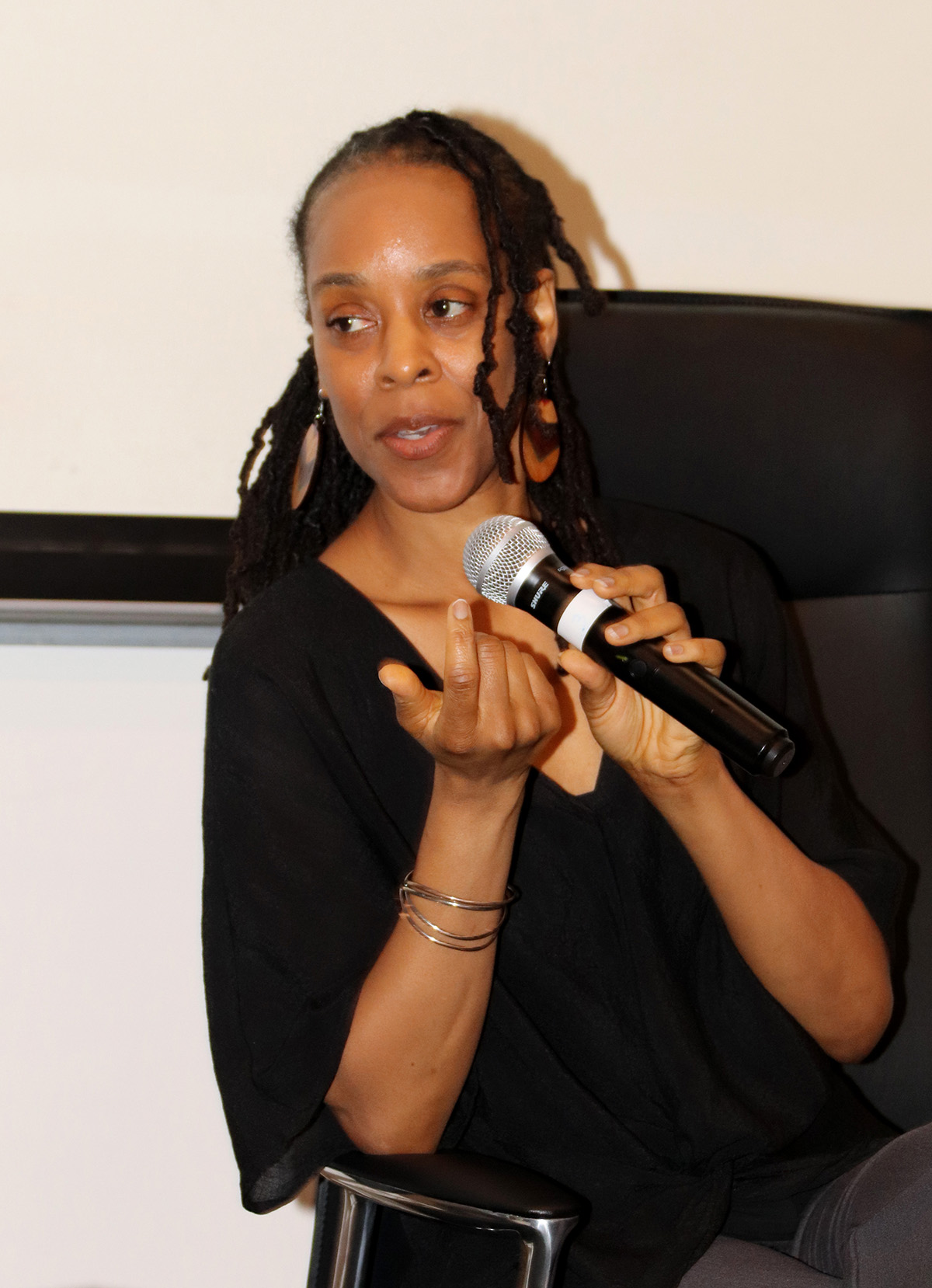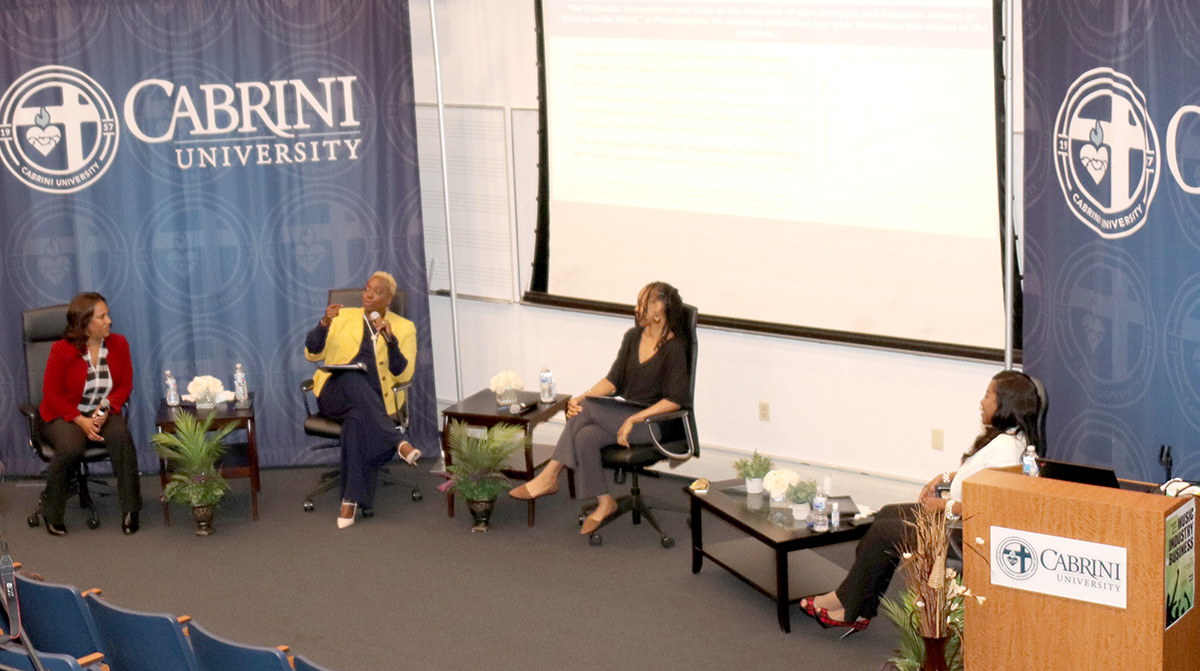Cabrini’s “Race in America” Common Hour panel sparked a wide-ranging discussion on race and inequality in American education, economic, and justice systems on Wednesday, September 16 in Widener Hall. Moderated by Provost and Vice President for Academic Affairs, Chioma Ugochukwu, PhD, the panel featured topical experts:
- Keir Bradford-Grey, the Chief Defender with the Defender Association of Philadelphia, who works to eradicate wrongful convictions, while establishing productive re-entry paths for incarcerated people.
- Zakia Y. Gates, PhD, an Assistant Professor of Teacher Education at Cabrini, who leans on a wealth of post-secondary and K-12 teaching experience to guide her research and pedagogy in matters of critical race theory, social justice, and Black female empowerment, among others.
- Andrea Lawful-Sanders, a WURD Radio host, WHYY contributor, former school board member whose programs advocated for greater student access to higher education and upward mobility, particularly for Black students in Montgomery County.
They shared their perspectives, as Black women, on recent news of police brutality and systemic racism. A limited number of attendees were present in Widener Hall for the discussion due to social distancing guidelines, while a larger virtual audience tuned in via YouTube live stream.
“The conversations we’re going to have today will be a little uncomfortable at times, but I think that’s OK,” Ugochukwu said before introducing the panel. “If we are trying to find solutions, then we must hold these uncomfortable conversations. Before you can solve a problem, you have to identify it.”
 Following months of nationwide social unrest sparked by graphic displays of violence in the streets of Minneapolis, MN, and Kenosha, WI, the panelists dissected racial biases that permeate community policing and education systems, as well as other inequalities exacerbated by the ongoing COVID-19 pandemic.
Following months of nationwide social unrest sparked by graphic displays of violence in the streets of Minneapolis, MN, and Kenosha, WI, the panelists dissected racial biases that permeate community policing and education systems, as well as other inequalities exacerbated by the ongoing COVID-19 pandemic.
“These civil rights moments don’t come lightly,” said Bradford-Grey. “They come because people have been ignored, dismissed, and devalued.”
The urgency evident in this year’s protests and riots is rooted in poverty and lack of opportunity, said Lawful-Sanders, pointing out how Black communities have been hit especially hard by the pandemic’s economic fallout. A former schoolboard member who conducted anti-racism trainings with many teachers and administrators, Lawful-Sanders suggested that this poverty is cyclical and feeds off corrupted systems. Black students, particularly boys, are unfairly stereotyped from a young age, she said, as educators tend to see less potential in Black students while subjecting them to harsher punishments.
“Many Black kids’ first interactions with police are in schools,” said Lawful-Sanders, who hosts “The Source” on Philadelphia’s African-American owned WURD Radio. “Often, Black boys have police records from their schools.”
This disciplinary approach taken within many school districts was one of several issues the panelists said caused the disproportionate incarceration of Black people in America.
Bradford-Grey cited a study conducted by Defender Association of Philadelphia which analyzed more than 300,000 police motor vehicle stops between October 2018 and September 2019 and found that Black drivers made up almost 75 percent of all car stops, despite representing less than half of Philadelphia’s population. Moreover, police were at least twice as likely to search the cars of Black drivers. This disparity  sows distrust, Bradford-Grey said.
sows distrust, Bradford-Grey said.
“It agitates the Black community so that they’re less likely to cooperate with police when trying to solve major crimes that are occurring in their own neighborhoods,” she said. “So these people are doubly taxed: They have high crime that is not being solved and they’re over-represented in the justice system for lower-level offenses—having more contact with police just by nature of being Black.”
Gates, an Assistant Professor of Teacher Education at Cabrini, said she wanted to “make it very clear that we don’t hate police officers,” referring to the phrase, “defund the police,” which has become a lightning rod for political debate in 2020. She said that some of the money in the police budget could be better allocated toward schools.
Bradford-Grey agreed that police funding was often misused. “The arrest rate for people committing violent crimes is under 30 percent,” she said. “We’re spending almost a billion dollars [in Philadelphia] on this notion of public safety and what you’re mostly doing is stopping Black drivers.”
Gates said she saw the National Guard in her community this summer, mentioning the increased militarization of law enforcement.
“There’s a price tag for that,” Bradford-Grey replied.
These policing trends also play into the proliferation of prison labor, which has become a mainstream talking point since the debut of “13th,” an Emmy-award winning documentary (2016) that explores modern implications of the 13th Amendment, which abolished slavery in 1865. Ugochukwu explained how one clause within the amendment, which forbids slavery and involuntary servitude “except as a punishment for crime…,” has created a loophole that enables corporations to supply their workforce with imprisoned laborers who are largely people of color.
 Gates offered another example of systemic racism that stripped a Black community of its wealth in a far quicker and more explicit fashion. “Many people don’t know about Black Wall Street,” she said, referring to a prosperous African-American community in Tulsa, OK, which was destroyed by racist violence in 1921. “That wiped out a whole generation of Black wealth.”
Gates offered another example of systemic racism that stripped a Black community of its wealth in a far quicker and more explicit fashion. “Many people don’t know about Black Wall Street,” she said, referring to a prosperous African-American community in Tulsa, OK, which was destroyed by racist violence in 1921. “That wiped out a whole generation of Black wealth.”
Opportunity gaps between different races create cultural misunderstandings that lead to increased fear, violence, and brutality, Bradford-Grey explained. “While I do think there are officers who are just blatantly racist, there are more who are just afraid,” she said. “They are afraid of the unknown. They don’t know us and our communities.”
It is Black men who are mostly swept up in this oppressive cycle, but it is their mothers and partners—Black women—who are left to shoulder much of the trauma, Ugochukwu observed. And, as each of the panelists attested, Black women are subjected to unfair stereotypes, too.
“Black women are perceived as being strong, tough, and less sensitive,” Gates said. “African American men call their women ‘strong’ but refer to their cars as ‘beautiful.’ That’s a big issue in our community. We are looked at as this trope of a strong, black woman—this machine that can take everything on.”
This trope also impacts Black women’s healthcare, Gates said, as their perceived toughness can result in lower doses of anesthesia during birth and other medical procedures.
Despite vast, deep-rooted inequalities and a ferocious ideological divide within the American citizenry, Gates emphasized that it is vital that we continue having conversations “as human beings.” Trying to understand the opposing view and calmly expressing one’s own opinion could create “a beautiful, wonderful conversation,” she said.
Cabrini’s “Race in America” panel itself, hosted in a lecture hall “with all different races talking openly and honestly” was cause for hope, Bradford-Grey said.
For Lawful-Sanders, the tide of young advocacy makes her optimistic for the future.
“What gives me hope are the young people who are not content to do business as usual as their parents were,” she said. “They are the ones shifting and shaping the country.”
Watch the entire panel on YouTube.

